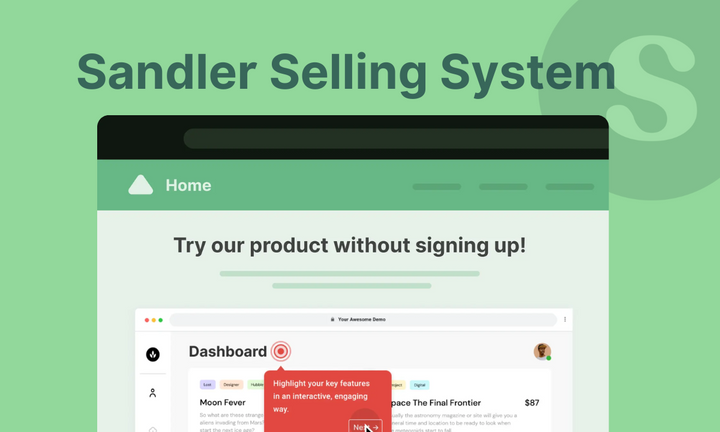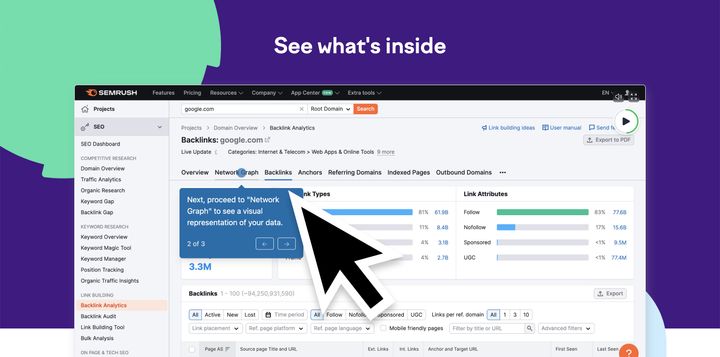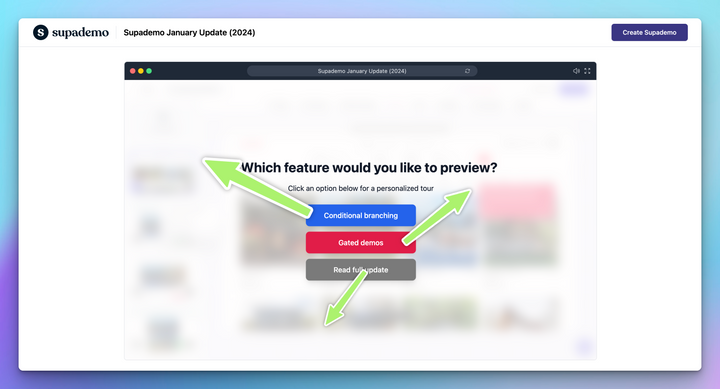Sales reps spend too much time with prospects who never buy. They chase unqualified leads, present to people without budgets, and wonder why their pipelines stay full but their close rates stay low.
The Sandler Selling System solves this problem by changing how you approach every sales conversation. In fact, data shows that 88% of sales professionals found their sales strategy got better after implementing this system.
In this guide, we walk you through the complete Sandler methodology step by step. So, let’s get straight into it!
- Pain before solutions: The Sandler system prioritizes uncovering emotional and business pain points before presenting any product features or capabilities.
- Upfront agreements: Every sales conversation begins with clear contracts about time, agenda, and expected outcomes to prevent surprises later.
- Equal partnership: Sandler positions sales reps and prospects as equals in a mutual evaluation process rather than traditional buyer-seller dynamics.
- Systematic disqualification: The methodology teaches when and how to remove poor-fit prospects from your pipeline to focus on genuine opportunities.
- Budget discussions required: Money conversations happen early in the process to ensure prospects have resources to solve identified problems.
- Decision process mapping: Sales reps uncover exactly how prospects make buying decisions before investing time in presentations or proposals.
- Consultative positioning: The system positions salespeople as advisors who may or may not be able to help based on discovered needs.
- Interactive demos enhance effectiveness: Modern sales teams using Supademo can apply Sandler principles while providing engaging product experiences that support qualification conversations.
What is the Sandler Selling System?
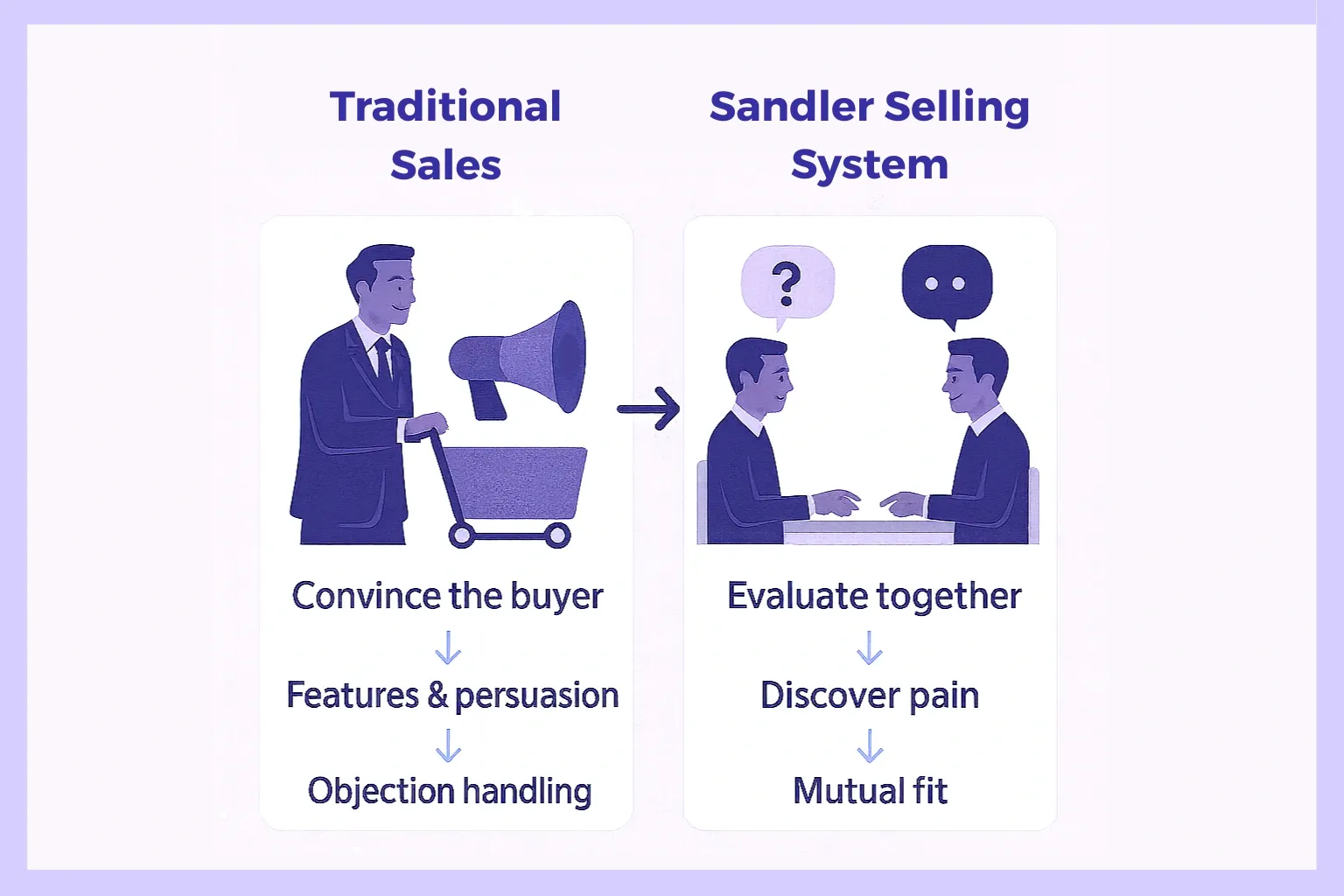
The Sandler Selling System , created by David Sandler in 1967, reverses traditional selling. Instead of persuading buyers with features, it positions salespeople as consultants who qualify prospects as much as prospects qualify them.
Prospects must prove they deserve help, easing buyer pressure and fostering honest conversations about real needs. Rather than pitching and handling objections, Sandler emphasizes uncovering problems and emotional pain points.
In fact, data shows that 50% more sales professionals were able to hit quotas after using the Sandler system, compared to those who didn't use this system.
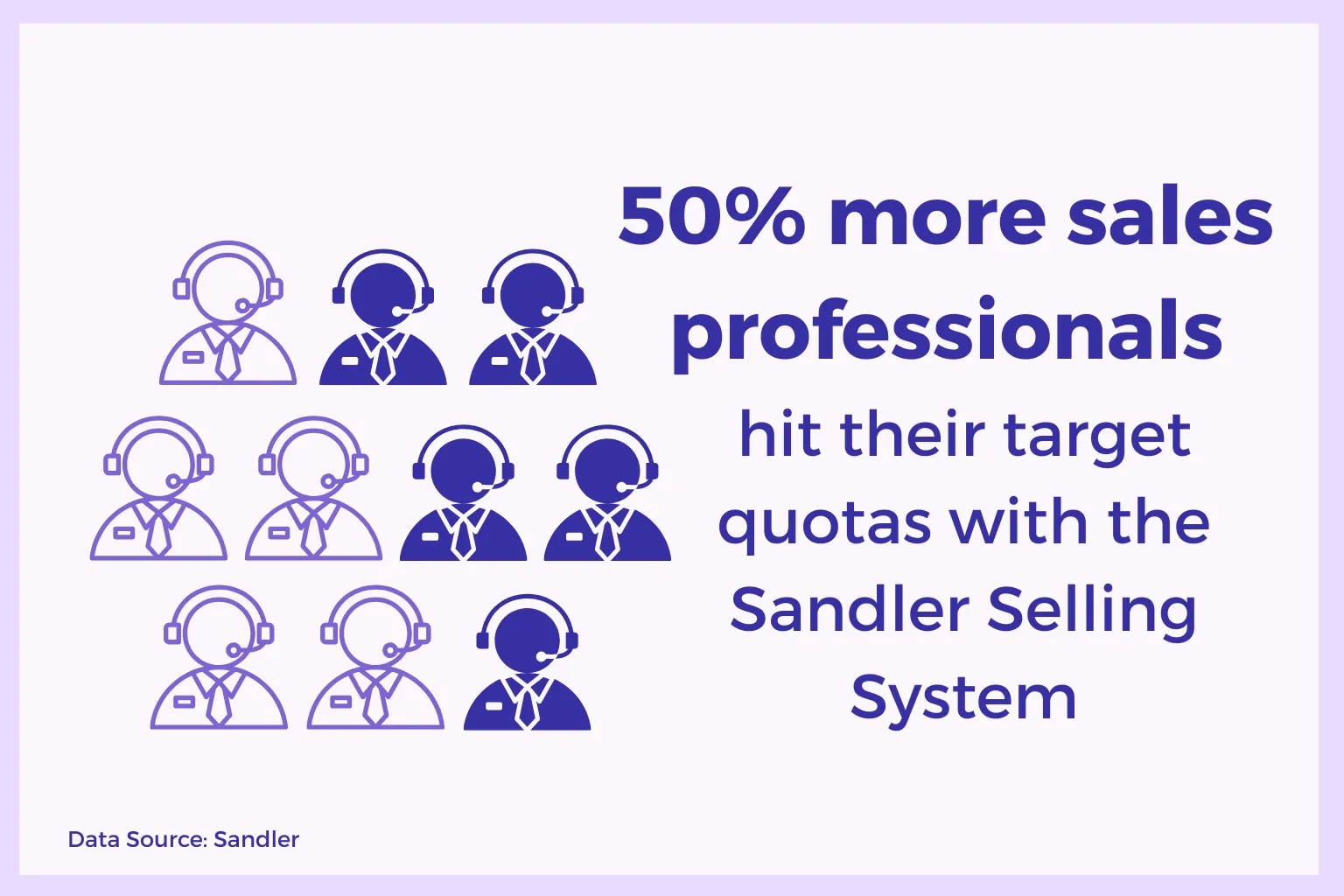
How many steps does the Sandler Selling System have?
The Sandler Selling System follows a 7-step process that guides every sales interaction from initial contact to closed deal. Each step must be completed before moving to the next one. Here’s how it works:
1. Bonding and rapport
Building genuine connections with prospects creates the foundation for honest business conversations. You need prospects to feel comfortable sharing real information about their challenges and decision-making processes.
Ways to build rapport effectively:
- Find common ground early: Look for shared professional experiences, mutual business connections, or industry challenges.
- Listen for personal details: Remember information they volunteer and use it to strengthen future conversations.
- Ask open-ended questions: Explore their background, company history, or recent business developments.
- Show genuine curiosity: Focus on understanding their world before shifting to business topics.
2. Up-front contract
Establishing clear expectations prevents misunderstandings and gives you permission to control the conversation flow. Every sales interaction should begin with an agreement about time, agenda, and next steps.
How to set an up-front contract:
- Confirm the time available: “We have 45 minutes scheduled today.”
- Outline the agenda: “I’d like to learn about your current challenges and see if there’s a fit.”
- Define the outcome: “At the end, we’ll decide together if a follow-up makes sense. Does that work for you?”
This approach immediately positions you as organized and respectful while giving you authority to ask direct questions. It also creates a framework for ending conversations that aren't progressing productively.
The up-front contract should address three key elements: time boundaries, meeting objectives, and decision criteria for next steps. Be specific about what you hope to accomplish and what information you need from them.
3. Pain discovery
Uncovering the emotional and business problems your prospects face becomes the foundation for everything that follows. Without sufficient pain, people won't prioritize making changes, regardless of how good your solution might be.
In the discovery call, ask questions that reveal both surface-level issues and deeper emotional impacts:
- Start broad: “What challenges are you facing with your current process?”
- Dig deeper: “How does that affect your relationship with your customers?”
- Explore consequences: If they mention slow reporting, ask how it impacts decisions, stress, or team productivity.
- Listen for emotional language: Words like frustrating, overwhelming, or keeping me up at night signal urgent problems.
- Capture their words: Take notes and reuse their exact language when presenting solutions later.
4. Budget and decision process
Determining whether prospects have financial resources and decision-making authority prevents wasted time on unqualified opportunities. Most sales reps avoid money conversations, but Sandler makes them mandatory.
Ask direct questions about budget allocation:
- "What resources have you set aside to address this problem?"
- "When issues like this come up, how does your company typically handle the investment required to solve them?"
If prospects resist, explain why budget conversations matter:
- "I want to make sure we explore solutions that fit within your financial parameters. It doesn't help either of us to discuss options you can't afford."
Also, map out their decision-making process completely:
- Who else needs to be involved in this decision?
- What criteria will they use to evaluate options?
- How have they made similar purchasing decisions in the past?
Understanding their buying process prevents surprises during negotiation. This qualification approach aligns especially well with the enterprise SaaS sales process, where multiple stakeholders and long cycles make early clarity critical.
5. Decision criteria
Helping prospects define their ideal solution requirements ensures you understand exactly what they need before presenting anything. This step prevents feature-focused presentations that miss their actual priorities.
Ask questions that help them articulate success criteria:
- "If we could solve this problem completely, what would that look like for your business?"
- "What specific capabilities would a solution need to have for you to consider it successful?"
Get them to prioritize their requirements by asking follow-up questions:
- "Which of these criteria is most important to you?"
- "If you had to choose between these two capabilities, which would have more impact on your business?"
This questioning process serves two purposes: it helps you determine if your solution matches their needs, and it gets them to verbalize the value they want.
When prospects define criteria themselves, they become more committed to finding solutions that meet those standards.
6. Fulfillment (presentation)
Present your solution only after completing thorough qualification in the previous five steps. Your presentation should directly address their stated pain points and match their defined criteria rather than covering generic product features.
How to structure the presentation:
- Frame around challenges: Reference their specific problems and outcomes.
- Use their language: Echo their own words when describing benefits.
- Keep it interactive: Ask throughout, e.g., “Based on what you shared about reporting, this feature addresses that specific problem. Does that match what you had in mind?”
- Avoid feature dumps: Every point should connect back to something they told you during qualification.
- Use interactive demos: Instead of static decks, interactive demos let buyers explore the solution themselves. This mirrors Sandler’s approach, where prospects prove the solution fits their needs. For teams using enterprise sales software, interactive demos integrate seamlessly into qualification workflows.
For example, Rb2B uses interactive demos in its sales process to let buyers explore the product hands-on. This way, prospects not only see how the solution addresses their pain but also demonstrate whether they’re committed enough to move forward.
7. Post-sell (reinforcement)
Reinforce their buying decision and address potential concerns after reaching an agreement. Many prospects experience uncertainty after making significant purchases, especially for solutions they haven't bought before.
How to reinforce effectively:
- Summarize value: Remind them how your solution solves their stated pain points.
- Confirm next steps: Review SaaS implementation timelines and responsibilities clearly.
- Provide proof: Share references, case studies, or run evaluations like proof of concept (POC) and proof of value (POV).
- Stay proactive: Schedule check-ins to ensure they see results and resolve issues before they grow.
- Use interactive demos: Offer personalized walkthroughs that reinforce adoption. These demos help customers revisit key features and reduce confusion, aligning with Sandler’s principle of ongoing mutual evaluation.
With Supademo, you can extend this experience beyond the demo call. You can bundle multiple interactive demos into a single link and share it as a sales leave-behind in your recap email. This lets stakeholders who missed the meeting explore the solution themselves, reinforcing confidence and keeping momentum strong.
Here’s an example of a multi-demo showcase:
What are the four guiding principles of the Sandler selling system?
There are four main principles that guide every aspect of the Sandler methodology and differentiate it from traditional sales approaches.
- Principle 1: Pain drives all buying decisions: People purchase solutions to problems that cause emotional or business discomfort. Without sufficient pain, prospects won't prioritize making changes. Sandler reps focus intensely on uncovering and developing pain before discussing any solutions.
- Principle 2: Complete transparency required: Both buyers and sellers should share honest information about their positions, concerns, and requirements. Hidden agendas and unclear communication waste time for everyone involved. Sandler encourages direct conversations where both parties reveal real constraints and expectations.
- Principle 3: Prospects must earn your attention: Traditional sales approaches position salespeople as subordinates trying to win business. Sandler reverses this dynamic, so prospects must demonstrate they deserve your time and solution. You evaluate them as carefully as they evaluate you.
- Principle 4: Buyer and seller equality: Neither party should feel pressured or manipulated during the SaaS sales process. Sales conversations become mutual evaluations where both sides determine fit. This equality reduces pressure and creates more productive discussions.
Sandler selling system vs. traditional sales methodologies
Knowing how Sandler differs from conventional sales approaches helps you apply the methodology more effectively. Here’s how they compare in terms of timing, positioning, and conversation flow.
Let’s take a detailed look at the key differences between both of the sales methodologies:
- Qualification approach: Traditional methods gather basic information about budget, authority, need, and timeline before presenting solutions. Sandler requires a thorough understanding of pain, emotional impact, decision processes, and success criteria before revealing any product capabilities.
- Presentation strategy: Conventional sales wisdom suggests demonstrating products early to generate interest and excitement. Sandler postpones all solution discussions until after complete qualification, then presents only capabilities that directly address identified pain points.
- Objection management: Traditional sales training teaches techniques to overcome resistance and change minds when prospects raise concerns. Sandler treats objections as qualification signals that indicate poor fit rather than obstacles to overcome.
- Follow-up philosophy: Standard approaches encourage persistent follow-up to stay visible and eventually convert hesitant prospects. The Sandler qualification removes the need for extensive follow-up because properly qualified prospects move forward while unqualified ones get removed from the pipeline.
- Relationship building: Traditional sales emphasizes enthusiasm, product knowledge, and persuasion skills to build credibility. Sandler prioritizes questioning abilities, listening skills, and the discipline to walk away from poor opportunities.
These principles are particularly effective in B2B inside sales, where reps must quickly separate qualified prospects from time-wasters.
What are the benefits of using the Sandler selling system in 2025?
The Sandler methodology delivers specific advantages that address common challenges in modern B2B sales environments.
1. Better prospect qualification: Sandler helps sales reps identify qualified opportunities faster, improves time allocation, and increases overall productivity.
Alex Vasylenko, the founder of Digital Business Card, highlighted:
“It's important to qualify leads early on in the sales process in the Sandler method. If salespeople ask the right questions at the start, they can focus on leads who are a good fit for their products. This means that more leads are converted and less time is spent on leads that aren't good.”
2. Shorter sales cycles: While initial qualification takes longer, overall sales processes often conclude faster because you avoid lengthy negotiations with unqualified buyers. Properly qualified prospects make decisions more quickly.
When asked about the Sandler selling systems, Nikita Sherbina, the Co-Founder & CEO of AIScreen, noted:
“By flipping the dynamic (buyers do most of the talking), reps act as trusted advisors. This resonates strongly with today’s skeptical, research-driven buyers.”
3. Higher close rates: Presenting only to thoroughly qualified prospects naturally improves win rates. When prospects have acknowledged pain, confirmed budget, and defined success criteria, they're more likely to move forward.
4. Reduced price pressure: Focusing on emotional pain before discussing solutions makes prospects less price-sensitive. They're buying solutions to acknowledged problems rather than comparing vendor features.
5. Improved customer relationships: Prospects who experience Sandler processes often report higher satisfaction with their buying experience. They feel understood rather than sold to, creating stronger long-term partnerships.
6. More accurate forecasting: Sales managers can predict outcomes more reliably because Sandler provides clear sales qualification criteria. Deals either meet standards for pipeline inclusion or get removed from forecasts.
7. Enhanced sales team confidence: Representatives become more consultative and strategic in their approach, positioning their companies as trusted advisors rather than vendor options.
Craig Klein, the CEO of SalesNexus, worked with a sales team consisting of a group of geologists with no prior sales experience at an energy service company. Sharing the experience, Craig highlighted:
“We engaged the Sandler franchise in Houston and it was a perfect fit for these scientists. It gave them a system to follow and helped them learn questioning techniques that naturally exposed the customers greatest needs so that our products could be positioned as the solution.”
8. Better resource allocation: Sales teams focus energy on opportunities with higher success probability instead of spreading efforts across unqualified prospects. Giving sales reps the right sales tech stack makes implementing Sandler principles even more effective.
Is there any limitation of using the Sandler selling system?
The Sandler system presents implementation challenges that organizations should consider before adoption.
1. Learning curve intensity: Sandler requires significant mindset changes for representatives accustomed to traditional sales approaches. The discipline needed for thorough qualification before presenting can feel unnatural initially.
2. Industry application varies: The methodology works best for consultative, relationship-based sales with longer cycles and higher values. Transactional or commodity sales may not justify the extensive qualification process.
3. Customer expectation management: Some prospects expect traditional sales presentations and may view Sandler questioning as evasive or unprofessional. This challenge appears more frequently in industries where product demonstrations are standard early in sales processes.
4. Implementation timeline: Most sales teams need several months to adopt Sandler principles consistently and see measurable results. Organizations seeking immediate sales improvements may find the timeline frustrating.
5. Cultural fit requirements: Sandler works best in organizations that support consultative selling and allow representatives to disqualify prospects. Companies with aggressive sales cultures may struggle with the methodology.
Take your Sandler selling system to the next level with Supademo
Applying Sandler principles effectively requires tools that support qualification without sacrificing prospect education. Traditional product demonstrations often conflict with the Sandler methodology by forcing prospects into presentations before complete qualification.
Supademo solves this challenge by providing interactive demos that prospects can explore independently while you focus on pain discovery and qualification.
Here’s how Supademo can help you:
- Lead qualification improves significantly: Replacing static sales assets with self-paced interactive demos engages prospects more effectively. Sales teams report a 36% increase in marketing qualified leads converting to sales qualified leads when using Supademo’s interactive demos during their qualification process.
- Sales cycles accelerate naturally: Interactive demos create highly engaged prospects who move through decision processes faster. Teams using Supademo see a 33% increase in deal velocity as prospects can explore solutions independently while sales reps focus on Sandler qualification techniques.
- Customer acquisition costs decrease: Personalized demo experiences with built-in tracking provide better insights into prospect behavior and interests. This targeted approach leads to a 28% reduction in customer acquisition costs compared to traditional static sales materials.
- Pain discovery becomes more effective: Create targeted demo scenarios that highlight specific problems prospects mention during qualification conversations. When they describe reporting challenges, show them a focused interactive demo of your automated reporting capabilities.
- More effective meetings: Prospects who have seen interactive demos come to sales meetings more educated and engaged. You can establish clearer expectations because they understand your capabilities and relevance to their situation.
Whether you're qualifying enterprise prospects or following up with mid-market opportunities, Supademo helps you maintain Sandler discipline while providing the product education prospects need to move forward confidently.
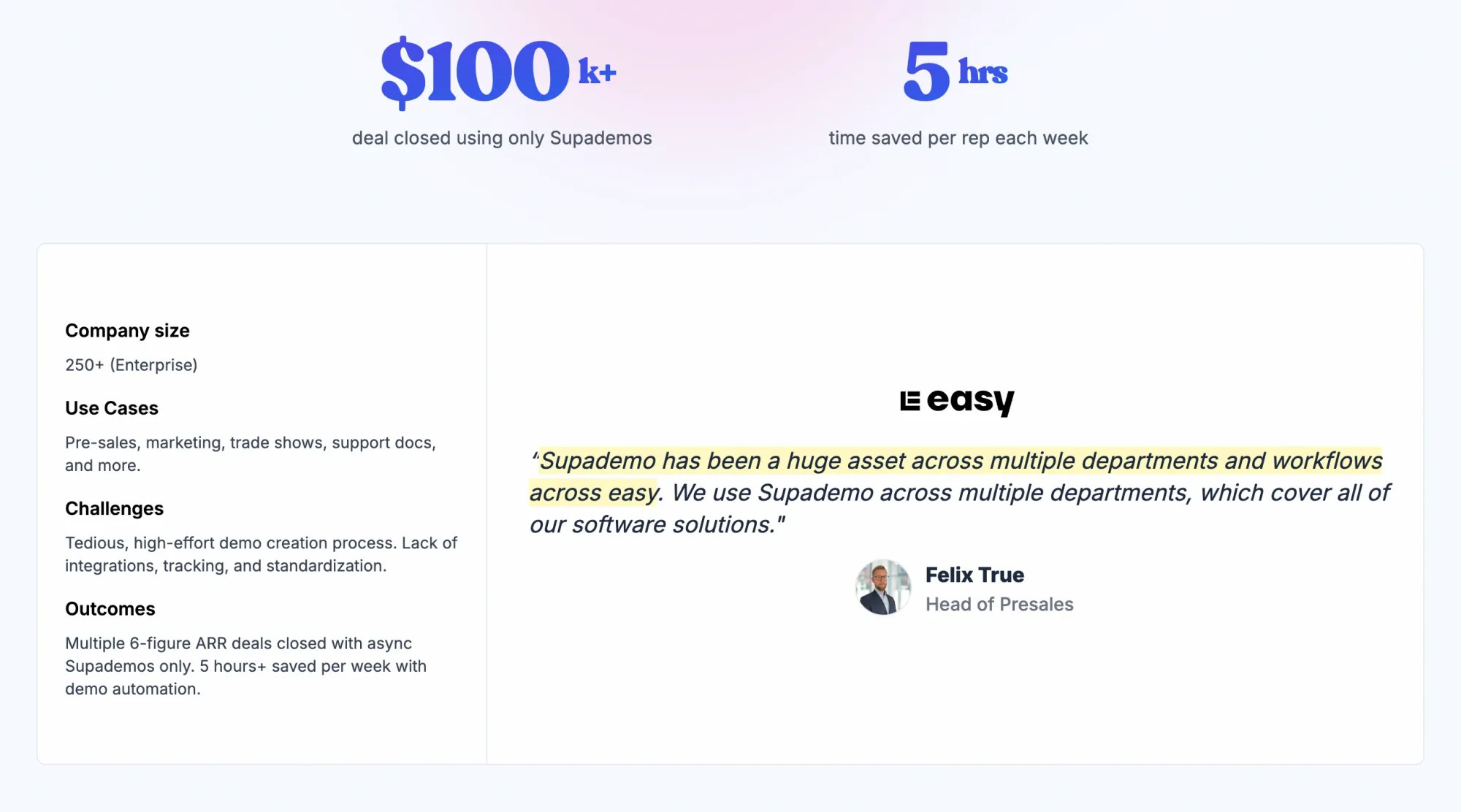
Ready to enhance your sales methodology with interactive demos? Try Supademo for free now!
FAQs
What makes the Sandler Selling System different from other sales methodologies?
Sandler reverses traditional sales approaches by requiring extensive qualification before any product presentation. The methodology treats buyers and sellers as equals who evaluate each other rather than salespeople pursuing prospects.
How long does it take to learn the Sandler Selling System effectively?
Most sales professionals need three to six months to become comfortable with Sandler techniques. Full implementation typically requires six to twelve months as the methodology demands significant mindset changes from traditional approaches.
Can the Sandler system work for all types of B2B sales situations?
Sandler works best for consultative sales with longer cycles and multiple decision makers. Transactional or commodity sales often lack sufficient complexity to justify the extensive qualification process.
What should you do if prospects refuse to discuss the budget during qualification?
Budget discussions are required in the Sandler methodology. If prospects won't engage in money conversations, they typically get disqualified as they lack serious buying intent or decision-making authority.
How does the Sandler system handle prospects who demand product demos early?
Sandler postpones demonstrations until after complete qualification. You acknowledge their request while explaining that understanding their specific needs first allows for more relevant product discussions.
What are the most common implementation mistakes with Sandler selling techniques?
Common mistakes include insufficient pain development, rushing through qualification to reach presentations, and failing to maintain equal partnership dynamics throughout the sales process.
How do you measure success when using the Sandler Selling System?
Key success metrics include qualification accuracy, time spent with unqualified prospects, close rates on qualified opportunities, and average sales cycle length for properly qualified deals.
Can existing sales teams adopt Sandler without disrupting current business?
Teams can implement Sandler gradually by applying techniques with new prospects while maintaining existing relationships through current methods. Systematic training and coaching support help ensure smooth transitions.
What role do product demonstrations play in the Sandler methodology?
Demonstrations happen only after complete qualification and focus specifically on addressing identified pain points rather than general feature education. Interactive demos often work better than traditional presentations.


